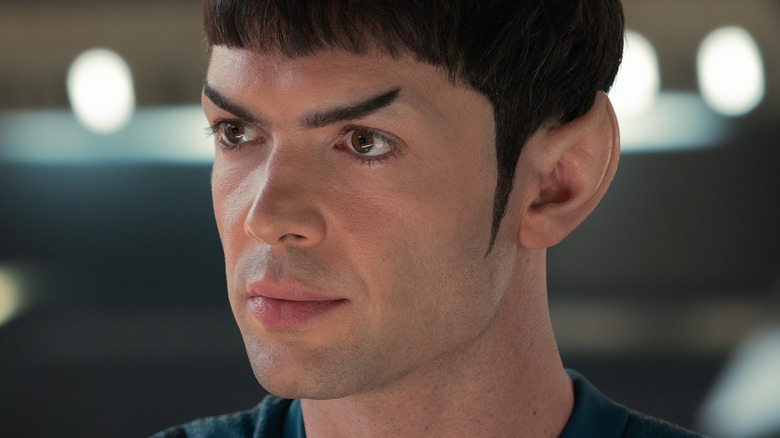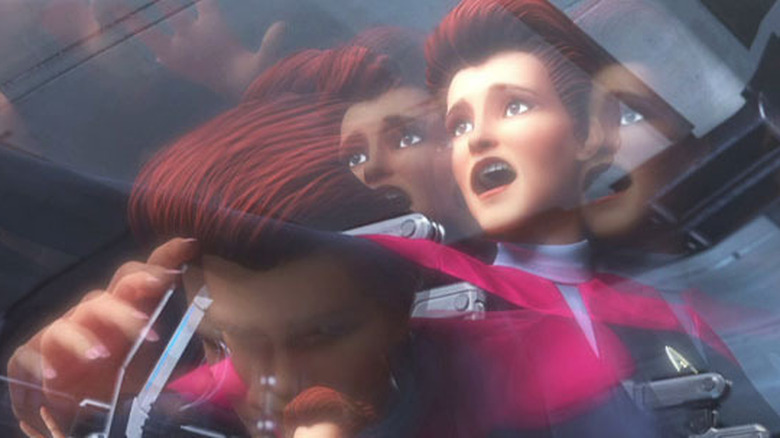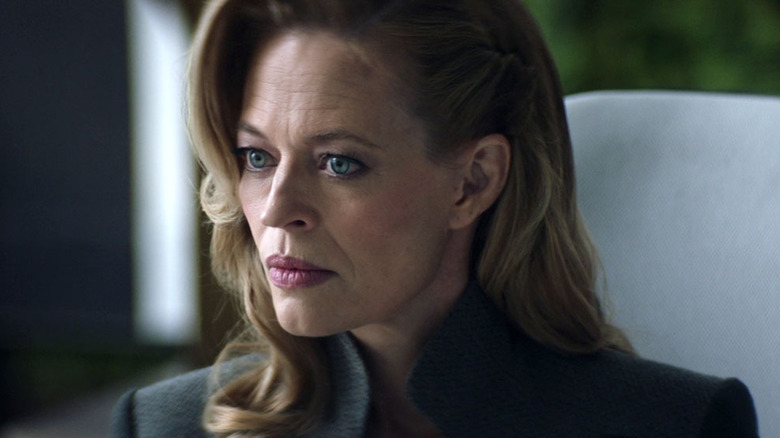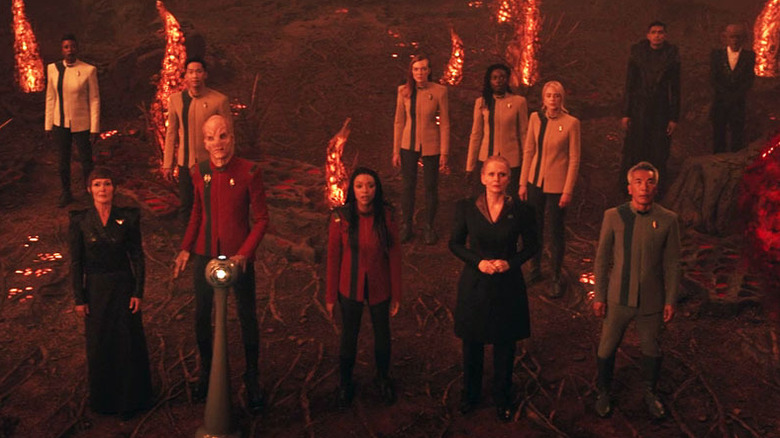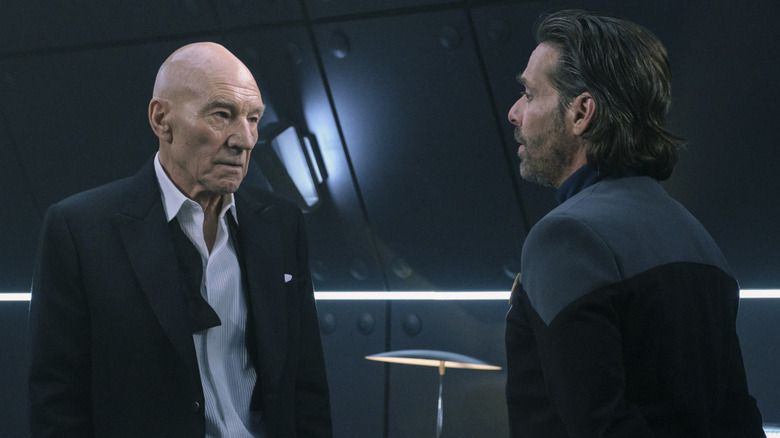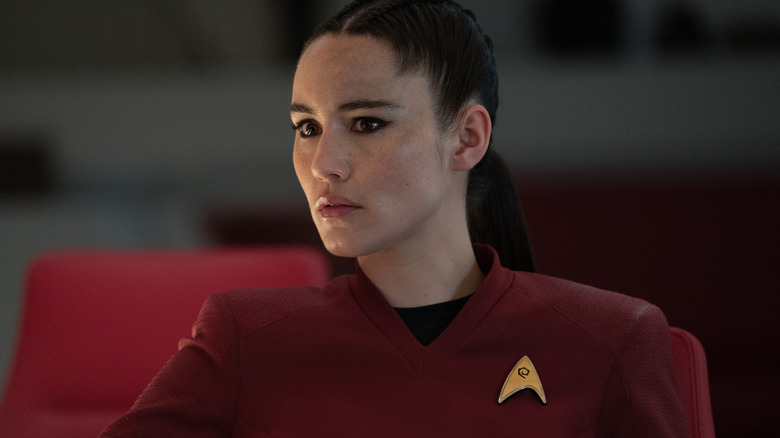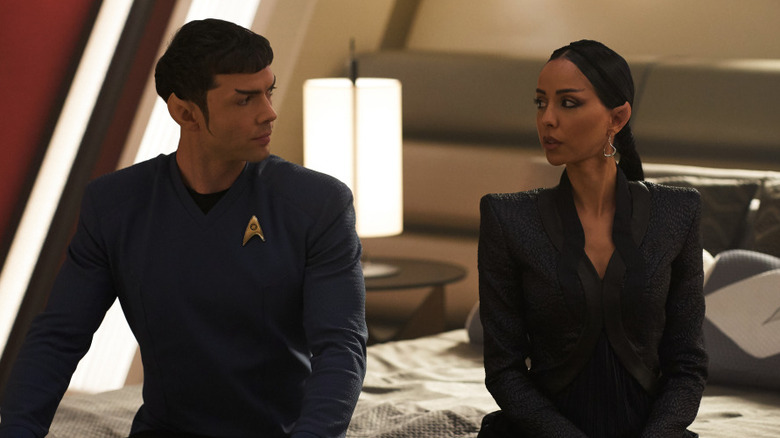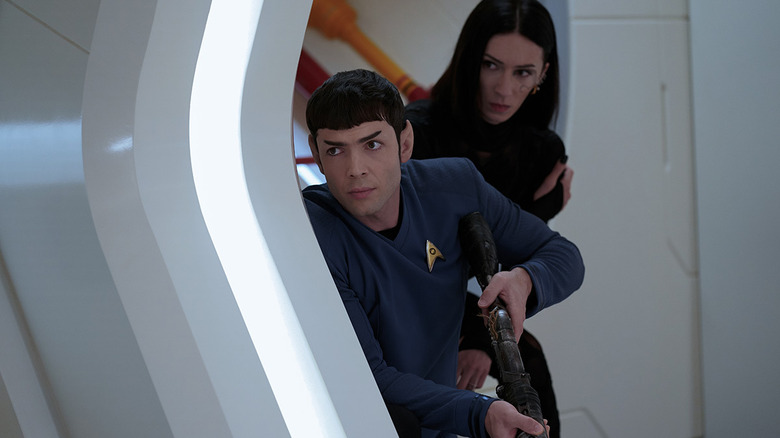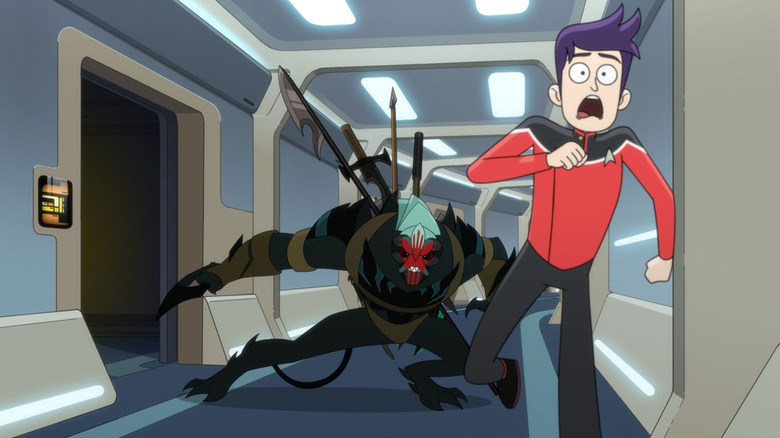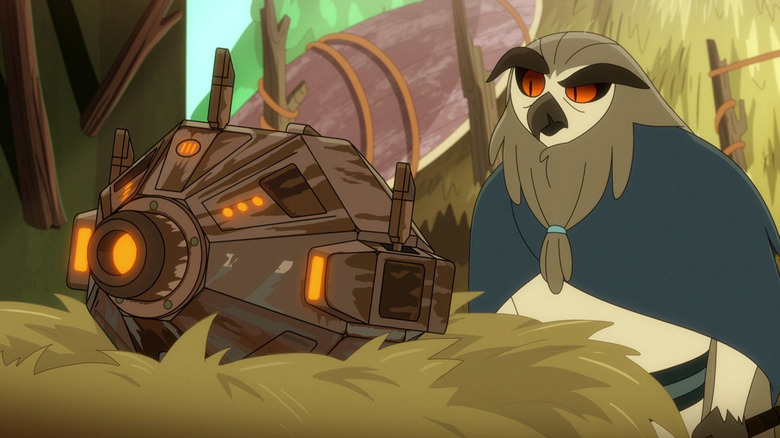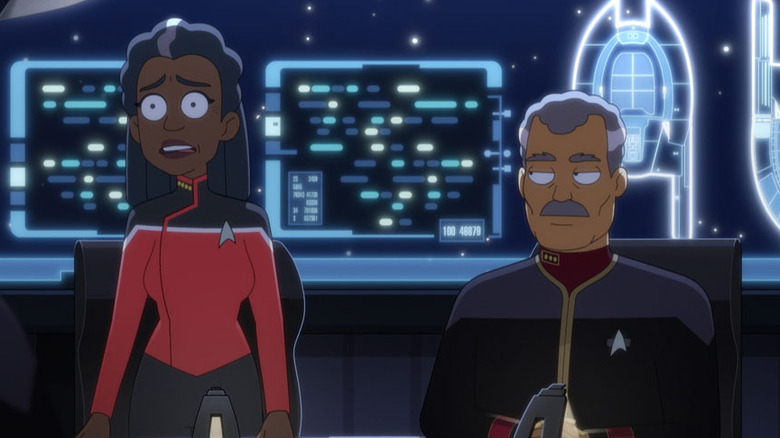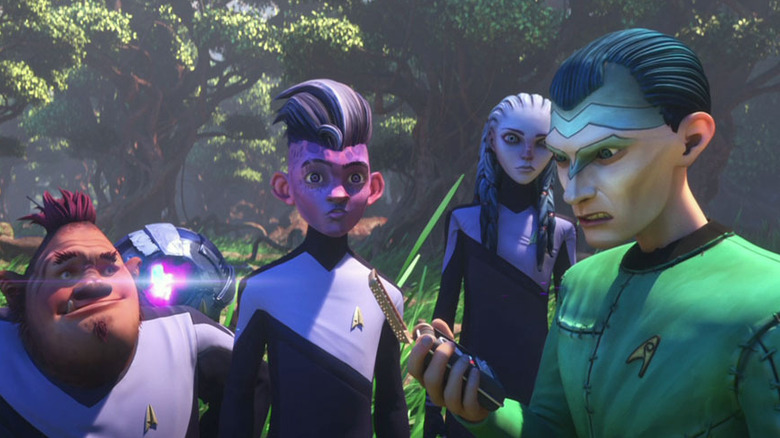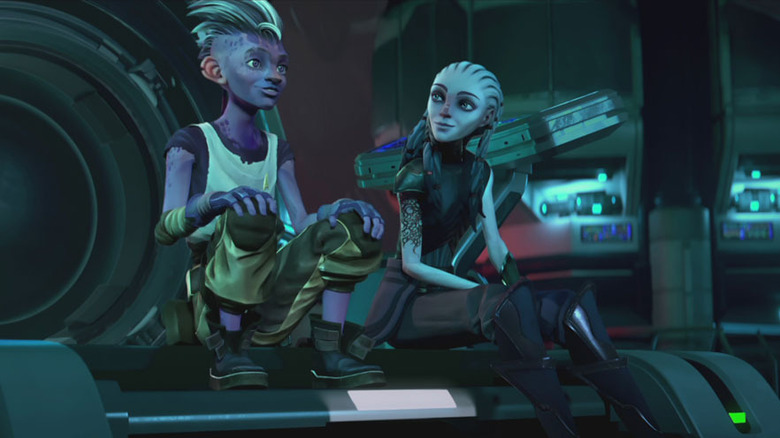The Best Star Trek Episodes Of 2022
2022 was a milestone year for the "Star Trek" franchise, marking the fifth anniversary of its rebirth on streaming television and its most prolific year since the mid-1990s. For the first time ever, episodes from five different "Star Trek" series debuted during the same calendar year, for a total of 51 episodes. That includes the tail end of "Star Trek: Discovery" Season 4, most of the giant-sized Season 1 of all-ages animated series "Star Trek: Prodigy," the debut of crowd-pleasing throwback "Star Trek: Strange New Worlds," plus new seasons of both the live-action "Star Trek: Picard" and the animated "Star Trek: Lower Decks." That's a whole lot of boldly going.
While quantity doesn't necessarily imply quality, this year's mountain of new "Star Trek" content shows off the diversity and versatility of the time-tested sci-fi universe. As the franchise expands, executive producer Alex Kurtzman and a growing team of writers and producers are finding a better balance between modern mores of streaming television and the more episodic approach of the old school. 2022's best "Star Trek" stories include live-action space adventures for adults, cheeky cartoon fun for kids, and every shade in between. Not every corner of the revitalized "Star Trek" universe will necessarily appeal to every fan, but each brings something exciting and different to the table as the canon continues to seek out new frontiers. In celebration of this, we're taking a look at the 12 best "Star Trek" episodes of 2022.
Time Amok (Prodigy)
The delightful "Star Trek: Prodigy" gradually introduces young (or otherwise uninitiated) viewers into the tropes, mythology, and values of "Star Trek." And what would a "Star Trek" series be without a clever time travel episode? "Time Amok" boasts a particularly terrific gimmick: the USS Protostar is splintered into six different "time zones," with the flow of time occurring at a different pace in each one. The ship will explode in 10 minutes, but those 10 minutes elapse in mere seconds for some of them, and years for others. Separated from each other, the squabbling crew is forced to figure out how to work together when they're very literally out of sync. Only Janeway (Kate Mulgrew), their holographic tutor, has the ability to move between the fragmented sections of time.
The structure of this episode allows for each character to get some individual growth and attention, but it's a particularly important chapter for Rok-Tahk (Rylee Alazraqui), the pre-adolescent rock creature who's assigned the role of security officer. When the time anomaly occurs, Rok is trapped in the slowest time frame, which means she's left alone for the relative equivalent of years. During this incredibly lonely period, she learns not only the multiple scientific disciplines required to save the ship, but the self-confidence to stand up for herself and pursue her true calling as a scientist.
Penance (Picard)
Season 2 of "Star Trek: Picard" kicks off by zapping the titular admiral and his band of misfits into a grim alternate timeline, where they serve the fascist Confederation of Earth. "Penance," the only chapter set entirely in this corrupted reality, is essentially a mirror universe episode, forcing Picard (Patrick Stewart), Seven of Nine (Jeri Ryan), and company to play-act as their evil counterparts. (This is a noteworthy treat, as Picard and Seven hail from the only previous live-action series to lack a mirror universe episode.) The stakes are high, as the Confederation isn't the product of a true parallel universe, but the result of meddling with Picard's own timeline. This means it won't be enough to simply escape — he'll have to travel back in time to prevent whatever disaster set this terrible future in motion.
It all culminates in a surprisingly violent confrontation between Picard and his old enemy Q (John de Lancie). Sadly, the season goes downhill from this point on by indulging in a six hour detour away from space adventures. But the high point that is "Penance" still stands strong.
Coming Home (Discovery)
The final chapter of "Star Trek: Discovery" Season 4, "Coming Home," is explosive. The Discovery crew's quest to prevent an extra-galactic mining operation from destroying entire planets has a lot of twists and turns, culminating in this ultimate confrontation between Captain Michael Burnham, her estranged partner Cleveland Booker, and the mysterious Unknown Species 10-C. The finale is an emotional roller coaster with perhaps too many near-catastrophes and last-second rescues, but, like the rest of the season, it's built on a rock-solid foundation: the relationship between Michael and Cleveland. Big feelings and arch drama are the double-edged sword of this series — since the cosmic and emotional stakes are always cranked to 11, it's hard for any galactic or personal conflict to really pop. But no one sells it better than star Sonequa Martin-Green and her on-screen love interest David Ajala. Their performances, more than the expensive-looking visual effects, give the season finale its punch.
Case in point, if there's one moment from "Coming Home" that lingers in our memory, it's the sustained close-up on Captain Burnham's face as she witnesses a terrible personal tragedy, wrestles with her shock and grief, and steadies herself to complete her mission. It's Martin-Green's most impressive piece of acting on the series to date, and considering how much heavy lifting she's done on "Star Trek: Discovery" over the first four seasons, that's saying a lot.
Monsters (Picard)
As rough as things get over the course of "Star Trek: Picard" Season 2, there are a few highlights. They mostly center around Jean-Luc Picard's psyche. This season's story arc forces the aged starship captain to confront the root cause of his inability to commit to a romantic relationship. Little by little, the details of Jean-Luc's difficult family life and the fraught relationship between his parents, Yvette and Maurice, come to light.
In the episode "Monsters," Picard unearths repressed memories from his childhood via a coma dream and the guidance of a stoic imaginary counselor portrayed by James Callis of "Battlestar Galactica" fame. Callis and Patrick Stewart are terrific scene partners, and it's fascinating and cathartic to watch them gradually peel back the layers of stubbornness and remorse that have, for so long, created distance between the legendary captain and those who love him most.
This storyline has real-world echoes: As he detailed in an essay for The Guardian, Stewart's father physically abused his mother during the actor's childhood. Such deep relevance makes an already excellent episode into an even more moving showcase for one of science fiction's most treasured stars.
If you or someone you know is dealing with domestic abuse, you can call the National Domestic Violence Hotline at 1−800−799−7233. You can also find more information, resources, and support at their website.
Memento Mori (Strange New Worlds)
"Star Trek: Strange New Worlds" heralds the welcome return of old-school, episodic "Star Trek" for the first time in two decades. The new series, set aboard the classic USS Enterprise under the command of Jim Kirk's predecessor, Captain Christopher Pike (Anson Mount), comes out swinging with 10 strong episodes, any of which could have found their way onto this list.
But as much as we enjoy the opening three episodes, the fourth has our eyes popping out of our heads. In "Memento Mori," the Enterprise is stalked through space by a bloodthirsty Gorn hunting party. Not only is this episode a thrilling, submarine-style thriller in the tradition of "Balance of Terror," it's also the first episode dedicated to exploring a character who is original to the series: Lt. La'an Noonien-Singh (Christina Chong). This standoffish security chief is the sole survivor of a brutal Gorn attack that killed her entire family, and the repeat encounter with the ravenous reptiles forces her to confront and overcome that trauma. Tense, exciting, and emotionally resonant, "Memento Mori" is a terrific introduction to one of the latest additions to the "Star Trek" family, and provides early evidence that "Star Trek: Strange New Worlds" offers more than cheap pops for nostalgic Trekkies.
Spock Amok (Strange New Worlds)
In addition to tight, one-and-done space adventures, "Star Trek: Strange New Worlds" restores another classic ingredient to the "Star Trek" recipe: camp. Since this series isn't burdened with sustaining season-long story arcs with ever-heightening peril, it's much easier for its storytellers to dabble in silly episodes. Season 1 has as many light and goofy installments as dark and gritty ones, resulting in some of the most delightful and charming new "Star Trek" episodes in decades.
Consider "Spock Amok," a broad comedy in which Enterprise science officer Spock — arguably the most iconic character in the history of the franchise — gets telepathically body-swapped with his even more stoic fiancée, T'Pring. It's a clever twist on the classic "Freaky Friday" plot: Instead of two drastically different characters switching places, actors Ethan Peck and Gia Sandhu are challenged to swap two painfully serious Vulcans. While their stern faces and flat affects seem identical at first blush, Spock and T'Pring's mix-up ultimately highlights just how different these two Vulcans really are. On top of being laugh-out-loud funny, "Spock Amok" is a terrific story that speaks to empathy and patience, two of the franchise's most precious values.
The Serene Squall (Strange New Worlds)
Our pick for best overall "Star Trek" episode of the year (and possibly the entire streaming era) is another goofy "Star Trek: Strange New Worlds" story, "The Serene Squall." Here, Pike, Spock, and the rest of the crew embark on a rescue mission, which sees them lock horns with colorful space pirates. If that sounds like pretty light fare, that's because it is — but only on the surface. "The Serene Squall" is mostly a zany adventure in which Spock and a mysterious new therapist (Jesse James Keitel) sneak around the captured Enterprise while kidnapped Captain Pike tries to turn his captors against each other. There's enough winking absurdity at play that you might briefly think you're watching "Star Trek: Lower Decks."
But there's also some interesting social allegory in the mix. All season long, Spock has been trying to make sense of his dueling human and Vulcan halves. Visiting therapist Dr. Aspen encourages him to try thinking about his identity beyond the binary — advice that's particularly resonant, as Dr. Aspen is non-binary themselves. "The Serene Squall" is a terrific example of the modern franchise's progressive philosophy. In earlier iterations of "Star Trek," gender and sexual diversity was only represented through sci-fi allegories (like the Trill, for example), whereas modern series display greater diversity. This allows them to explicitly portray a more inclusive future and add greater texture to their sci-fi storytelling.
The Least Dangerous Game (Lower Decks)
"Star Trek: Lower Decks" has done a lot of growing over the course of its three seasons. The animated sitcom now boasts the most lovable and developed crew in modern "Star Trek" and a well fleshed-out corner of the canon's universe. "The Least Dangerous Game" is a textbook example of a "Star Trek: Lower Decks" episode, demonstrating both why the show works and how much it's changed. As usual, Ensign Mariner (Tawny Newsome) is stuck doing boring grunt work. But while she once would have looked for any way to circumvent her supervisor's authority, she now actively avoids cutting corners in an effort to repair her relationship with her mother, Captain Freeman (Dawnn Lewis). Ensign Boimler (Jack Quaid), meanwhile, gets in over his head and spends a lot of the episode screaming and running for his life (which is his main occupation on the show). But instead of the danger being ironic penance for his attempts to play things safe, it's just desserts for his new "Bold Boimler" persona, as he actually volunteers to be ritualistically hunted by an alien ambassador.
"Star Trek" tropes are lampooned and subverted along the way, winking references are made to classic series, and a great time is had by all. It's the sort of episode that you could set in front of someone who's never watched "Star Trek: Lower Decks" before, knowing that by the time the credits roll, they'll completely understand the show's appeal.
A Mathematically Perfect Redemption (Lower Decks)
"Star Trek: Lower Decks" takes its name and premise from an episode of "Star Trek: The Next Generation" that breaks away from that show's usual format to focus on a different set of characters. This reveals a new perspective on the adventures fans are used to watching. Appropriately, "Star Trek: Lower Decks" carries on this tradition, reserving one episode per season (beginning with Season 2) to experiment with new settings or subjects that don't usually appear on the series. Last season, fans got "wej Duj," which shows us a day in the life of junior officers aboard Klingon and Vulcan ships. This season's offbeat episode is "A Mathematically Perfect Redemption," which centers almost entirely around a character we haven't seen in a while: Peanut Hamper (Kether Donohue), the treacherous robotic ensign who left the rest of the Cerritos crew to die back in the Season 1 finale.
"A Mathematically Perfect Redemption" finds Peanut Hamper stranded on a planet of bird people, who she initially plans to exploit for her own gain, but gradually comes to care about. As the title suggests, it's a transformational journey for Peanut Hamper that sets her on a collision course with the series regulars, who aren't terribly happy to see her. Hilarious and surprisingly raunchy fun ensues, leaving the door open for future adventures of the mean little Excocomp with the mathematically perfect name.
The Stars at Night (Lower Decks)
While "Star Trek: Lower Decks" is mostly a light comedy that relishes the banality of workaday life, it consistently ramps up the drama in time for each season finale. These intense episodes throw the series' silliness into brilliant contrast, and are compelling enough to stand up to classics of the 1990s. Season 3's finale, "The Stars at Night," is no exception. Here, the fate of the USS Cerritos and the entire California-class fleet is jeopardized by a new automated starship. This challenge puts not only the lives of our characters in danger, but also their pride and purpose. It all culminates in a heartwarming demonstration of (very literal) class solidarity.
What makes "The Stars at Night" a particularly satisfying finale is how much it demonstrates the confidence that the series has acquired over the past three years. While still definitely reliant on references and guest stars from previous "Star Trek" series, "The Stars at Night" doesn't hinge on borrowed charm like a surprise appearance from Captain Riker or the debut of the long-rumored Cetacean Ops. This time, it's cameos from various characters who are original to "Star Trek: Lower Decks" that make the episode feel special. It's proof that this series has established itself enough to merit nostalgia of its very own.
All the World's a Stage (Prodigy)
Though "Star Trek: Prodigy" is designed to stand on its own, it's still littered with references to the franchise's dense mythology. Every once in a while, the show's storytellers indulge themselves by blatantly playing to the grown-up fans in the room. One such example comes late in Season 1 with "All the World's a Stage," an episode with deep roots in both the on-screen and behind-the-scenes legacy of "Star Trek."
Back in 1996 (via Heavy), the writers of "Star Trek: Deep Space Nine" kicked around an episode idea for the franchise's 30th anniversary, in which their show's crew would return to the planet from the "Star Trek: The Original Series" episode "A Piece of the Action." There, they'd discover its impressionable populace has become obsessed with the crew of the USS Enterprise and rebuilt their entire culture around it. This would allow the writers to playfully poke fun at both "Star Trek" fan culture and the classic '60s series. Ultimately, however, this idea was scrapped.
But in "All the World's a Stage," the young crew of the USS Protostar come across a planet whose own encounter with Kirk's Enterprise has made them deeply reverent towards Starfleet. Essentially, they're Trekkies living within the "Star Trek" universe. It's a sweet little episode that highlights what makes Starfleet so inspiring, both to those who meet its officers in person and those who watch them on TV.
Supernova (Prodigy)
Season 1 of "Star Trek: Prodigy" wraps up in glorious fashion with the two-part finale "Supernova." This installment concludes the Protostar crew's arduous journey from captivity in the Delta Quadrant to the heart of the United Federation of Planets. Along the way, they learn the value of curiosity, cooperation, and compassion, and a great deal about their own aims and origins. Now comes their final test, as the trojan horse computer virus that's been secreted aboard the Protostar is unleashed upon Starfleet, leaving the fate of the entire Federation in the hands of this ragtag group of unruly kids, their holographic mentor, and the real Starfleet icon upon which she's based: the legendarily fierce Vice Admiral Kathryn Janeway.
"Star Trek: Prodigy" is a show for children, and therefore graded on a slightly different curve than the "Star Trek" shows made for grown-ups. But "Supernova" stands out as an example of just how little its "kids' cartoon" limitations hinder the viewing experience for adults. While the tone and art style of the show definitely read as Nickelodeon programming, very little about "Star Trek: Prodigy" feels dumbed-down or condescending. Its characters' journeys are fulfilling and complex, the visuals are creatively conceived and artfully executed, and the franchise's philosophy of acceptance and self-sacrifice isn't watered down in the least. It's all on display in "Supernova," where it shines as brightly as the stellar explosion for which it's named.
